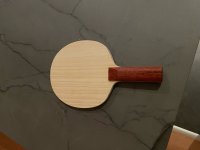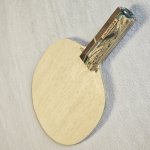This user has no status.
Member
Hello tabletennis friends!
I am a 42yo TT-player from Germany and i had been playing tabletennis in my youth but stopped at the age of 17. Then I came back to this great sport 2 years ago. So my gameplay is not alot better than rubbish but I have fun most of the time playing tt and get better slowly.
In the last 2 years I have tested lots of blades and rubbers.
Then I recently started to create my own blades because I was curious what I could do and how different compositions would behave. Now it is both fun to build and to test them. Meanwhile I made a blade for my trainer and another one for a friend and also sold my first blade which was a bit too slow for my game.
I am working fulltime and have a family, so one blade per week is a benchmark for me.
The handle is the most demanding part for me as I dont have professional equipment. Today my 10yo son helped me to cut some wood for the next handles and we had a lot of fun. He even asked me if he could build his own blade- I answered I am not sure as its not easy but now I think i should support him. Maybe this engages him to play more often.
Here are my first 2 blades (ive made 12 so far)- I will have to add the frequencies later as some blades are still in use from time to time and I have to remove the rubbers first.
The name "T-blades" comes from my 2nd first name starting with a "T".
Nr.1

Limba-Basalt-Abachi-Kiri-Abachi-Basalt-Limba, 5,9mm
Inner layers glued with white wood glue (water resistant) and the rest glued with epoxy.
Smaller handle (cherry, nut and pear) as I like to play with grip tape. It is a bit heavy at ~90g so I then built...
Nr.2
Limba-Basalt-Abachi-Kiri-Abachi-Limba as before but selected less dense veneers and used a little less glue- 5,7mm.
I built a new handle recently because it had a handle made from mdf first and that led to a mushy feeling overall.
New one is made of abach and louro preto which has a brighter color on the edges (sapwood). The louro preto has a very rough surface so its very promising to have good grip and sweet absorption even without tape.
This is 83g now but I didnt play it with the new handle (and I cant till January due to an injury)



I will post more tomorrow- good night!
I am a 42yo TT-player from Germany and i had been playing tabletennis in my youth but stopped at the age of 17. Then I came back to this great sport 2 years ago. So my gameplay is not alot better than rubbish but I have fun most of the time playing tt and get better slowly.
In the last 2 years I have tested lots of blades and rubbers.
Then I recently started to create my own blades because I was curious what I could do and how different compositions would behave. Now it is both fun to build and to test them. Meanwhile I made a blade for my trainer and another one for a friend and also sold my first blade which was a bit too slow for my game.
I am working fulltime and have a family, so one blade per week is a benchmark for me.
The handle is the most demanding part for me as I dont have professional equipment. Today my 10yo son helped me to cut some wood for the next handles and we had a lot of fun. He even asked me if he could build his own blade- I answered I am not sure as its not easy but now I think i should support him. Maybe this engages him to play more often.
Here are my first 2 blades (ive made 12 so far)- I will have to add the frequencies later as some blades are still in use from time to time and I have to remove the rubbers first.
The name "T-blades" comes from my 2nd first name starting with a "T".
Nr.1
Limba-Basalt-Abachi-Kiri-Abachi-Basalt-Limba, 5,9mm
Inner layers glued with white wood glue (water resistant) and the rest glued with epoxy.
Smaller handle (cherry, nut and pear) as I like to play with grip tape. It is a bit heavy at ~90g so I then built...
Nr.2
Limba-Basalt-Abachi-Kiri-Abachi-Limba as before but selected less dense veneers and used a little less glue- 5,7mm.
I built a new handle recently because it had a handle made from mdf first and that led to a mushy feeling overall.
New one is made of abach and louro preto which has a brighter color on the edges (sapwood). The louro preto has a very rough surface so its very promising to have good grip and sweet absorption even without tape.
This is 83g now but I didnt play it with the new handle (and I cant till January due to an injury)
I will post more tomorrow- good night!
Last edited:












